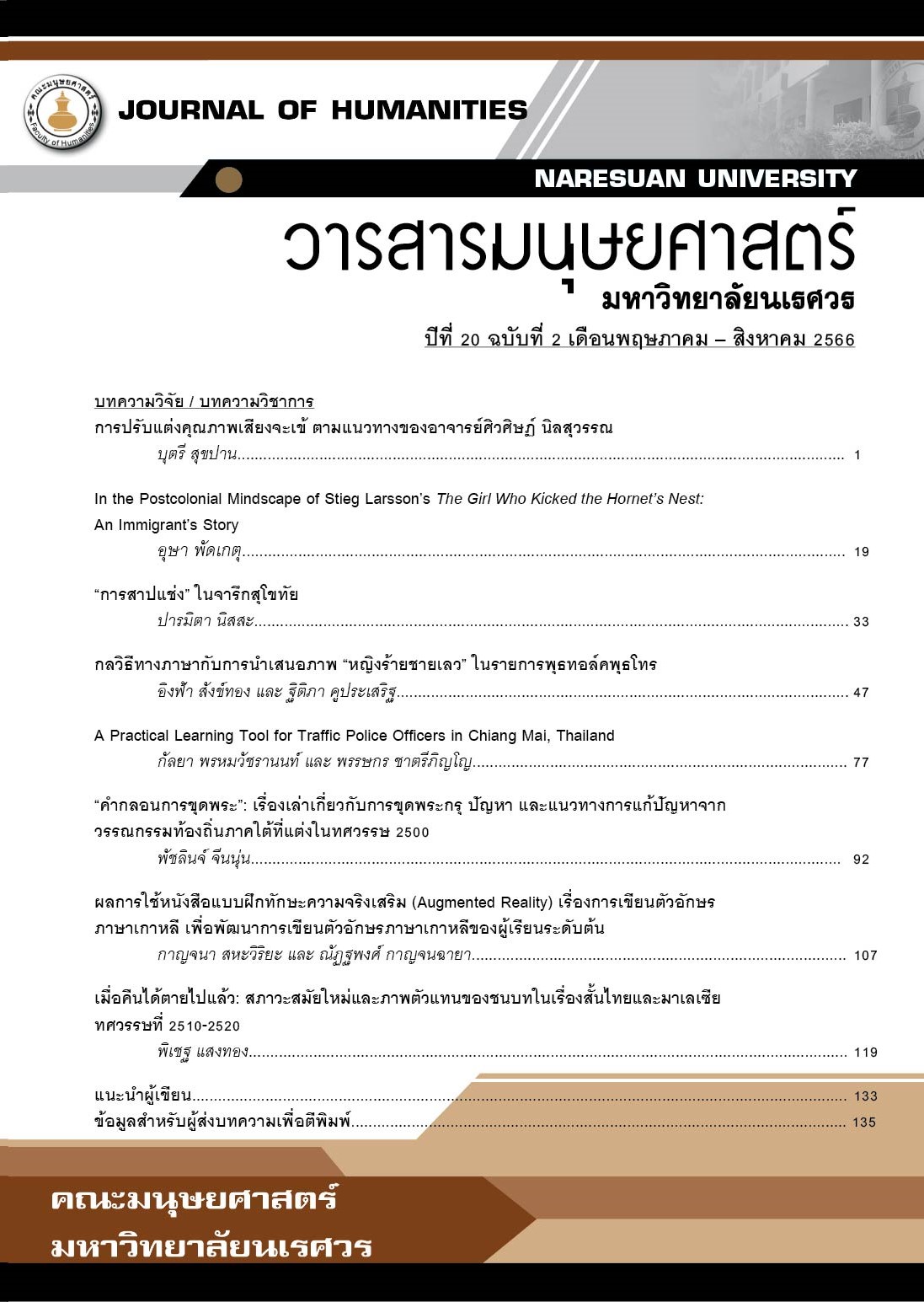ในจิตตทัศน์หลังอาณานิคมของนวนิยายเรื่อง เดอะ เกิร์ล ฮู คิคท์ เดอะ ฮอร์เน็ทส์ เน็สท์ โดย สตีก ลาร์สัน: เรื่องของคนนอก
Main Article Content
บทคัดย่อ
การศึกษานี้มีจุดประสงค์เพื่อวิเคราะห์คตินิยมแบบยุคอาณานิคมที่มีต่อตัวละครชื่อ ไอดริส กิดี ซึ่งเป็นคนนอกที่ลี้ภัยมาจากประเทศอิรักในนวนิยายเรื่อง เดอะ เกิร์ล ฮู คิคท์ เดอะ ฮอร์เน็ทส์ เน็สท์ ประพันธ์โดย สตีก ลาร์สัน และเพื่อวิเคราะห์บทบาทของตัวละครชายขอบนี้ในการล้มล้างการครอบงำแนวอาณานิคมในนวนิยายเรื่องดังกล่าว โดยนำแนวคิดเกี่ยวกับจิตตทัศน์และทฤษฎีวิจารณ์วรรณกรรมแนวหลังยุคอาณานิคมมาใช้ศึกษาคตินิยมทั้งแบบอาณานิคมและแบบต้านอาณานิคมที่พบในการดำเนินท้องเรื่องเกี่ยวกับกิดี ผลการศึกษาแสดงให้เห็นว่าจิตตทัศน์ของกิดีช่วยทำให้เขารอดพ้นจากสำนึกอาณานิคมที่อาจบีบบังคับให้เขามองตนเองในแง่ลบได้ นอกจากนี้ยังพบว่าถึงแม้กิดีจะตกอยู่ในสถานะคนชั้นล่างผู้ไร้ปากเสียงซึ่งลิดรอนโอกาสทางสังคมและเศรษฐกิจของเขาเป็นอย่างมาก แต่เขาก็ได้แสดงออกถึงการต่อต้านในระดับจิตใจและมีส่วนในการโค่นล้มหน่วยปกครองที่ฉ้อฉลหน่วยหนึ่งในนวนิยายเรื่องนี้
Article Details

อนุญาตภายใต้เงื่อนไข Creative Commons Attribution-NonCommercial-NoDerivatives 4.0 International License.
ข้อความรู้ใด ๆ ตลอดจนข้อคิดเห็นใด ๆ เป็นของผู้เขียนแต่ละท่านโดยเฉพาะ คณะมนุษยศาสตร์ มหาวิทยาลัยนเรศวร และกองบรรณาธิการวารสารมนุษยศาสตร์ฯ ไม่จำเป็นต้องเห็นพ้องด้วย
เอกสารอ้างอิง
Beckmann, K. M. (2016). The millennium series and the girl with the dragon tattoo – Featuring yet another criminal psychiatrist: A screenplay psychiatrists should be aware of. Australasian Psychiatry, 24(3), 315-316. Retrieved January 21, 2021, from https://doi.org/10.1177/1039856216629840
Benyahia, S. C. (2013). Salander in cyberspace. In S. Peacock (Ed.), Stieg Larsson’s Millennium trilogy: Interdisciplinary approaches to Nordic Noir on page and screen (pp. 58-78). U.K.: Palgrave Macmillan.
Bergh, A. (2014). Sweden and the revival of the capitalist welfare state. Cheltenham, UK: Edward Elgar.
Bjørgo, T. (1993). Militant neo-Nazism in Sweden. Terrorism and Political Violence, 5(3), 28-57.
Broberg, G. & Tydén, M. (2005). Eugenics in Sweden: Efficient care. In G. Broberg & N. Roll-Hansen (Eds.), Eugenics and the welfare state: Norway, Sweden, Denmark, and Finland (pp. 77-150). East Lansing: Michigan State University Press.
Creeber, G. (2015). Killing us softly: Investigating the aesthetics, philosophy and influence of Nordic Noir television. Journal of Popular Television, 3(1), 21-35.
Editorial Reviews. (n.d.). The Millennium trilogy. Amazon. Retrieved January 20, 2021, from https://www.amazon.com/Millennium-Trilogy-Stieg-Larsson-ebook/dp/B01CUJA454
Faculty of Humanities NU. (2021, February 16). Pathakatha phiset phama pha thi: Mum mong nakwichakan to sathanakan patchuban doi Professor Michael Charney [A special lecture on Myanmar dialogues: A scholar’s take on the current situations] [video]. Retrieved February 25, 2021, from https://www.youtube.com/watch?v=T8Cil_kETiw
Forshaw, B. (2013). The Larsson phenomenon: Sales figures and sexual abuse. In S. Peacock (Ed.), Stieg Larsson’s Millennium trilogy: Interdisciplinary approaches to Nordic Noir on page and screen (pp. 12-34). U.K.: Palgrave Macmillan.
Freeman, R. B., Swedenborg, B., & Topel, R. (2010). Introduction. In R. B. Freeman, B. Swedenborg & R. Topel (Eds.), Reforming the welfare state: Recovery and beyond in Sweden (pp. 1-23). Chicago: The University of Chicago Press.
Grodal, T. (2011). Crime fiction and moral emotions: How context lures the moral attitudes of viewers and readers. Northern Lights: Film and Media Studies Yearbook, 9(1), 143-157.
Hansen, K. T., & Waade, A. M. (2017). Locating Nordic noir: From beck to the bridge. Switzerland: Palgrave Macmillan.
Henderson, D. (2014). Thor's mighty hammer: Christianity, justice and Norse mythology in Stieg Larsson's Millennium trilogy. The Journal of Popular Culture, 47(5), 1047-1061.
King, D. & Smith, C. L. (2012). Men who hate women and women who kick their asses: Stieg Larsson’s Millennium trilogy in feminist perspective. Nashville, Tennessee: Vanderbilt University Press.
Larsson, S. (2010). The Girl Who Kicked the Hornet’s Nest. New York: Vintage.
Ma, S. (2014). My aspergirl: Stieg Larsson’s Millennium trilogy and visualizations. The Journal of American Culture, 37(1), 52-63.
Maryles, D. (2011). The winning game: 2010 Hardcovers: Facts & figures 2011. Publishers Weekly. Retrieved February 26, 2021, from https://www.publishersweekly.com/pw/by-topic/industry-news/publisher-news/article/46541-the-winning-game-2010-hardcovers-facts-figures-2011.html
Orange, R. (2018, August 9). Sweden Democrats can't shake neo-Nazi tag. DW. Retrieved September 3, 2021, from https://www.dw.com/en/neo-nazi-background-hounds-swedendemocrats/a-45344978
Padgate, U. & Padgate, W. (2020). The metatextuality of crime fiction in The Girl with the Dragon Tattoo: A homage with a twist to golden-age detective fiction. In ARUCON2020 Proceedings (pp. 189-193). Phranakhon Si Ayutthaya: Phranakhon Si Ayutthaya Rajabhat University
Said, E. W. (1994). Culture and imperialism. New York: Vintage Books.
Said, E. W. (2003). Orientalism. London: Penguin Books.
Spivak, G. C. (1990). The post-colonial critic: Interviews, strategies, dialogues. New York: Routledge.
Stenport, A. W. (2012). Corporations, the welfare state, and covert misogyny in the Girl with the Dragon Tattoo. In D. King & C. L. Smith (Eds.), Men who hate women and women who kick their asses: Stieg Larsson’s Millennium trilogy in feminist perspective (pp. 123-134). Nashville, Tennessee: Vanderbilt University Press.
Tawat, M. (2011). Two tales of Viking diversity: A comparative study of the immigrant integration policies of Denmark and Sweden, 1960-2006 (Doctoral dissertation). Dunedin: University of Otago.
Thomas, B. (2012). Kicking the hornet’s nest: The rhetoric of social campaigning in Stieg Larsson’s Millennium trilogy. Language and Literature: International Journal of Stylistics. 21(3), 299-310.
Tyson, L. (2006). Critical theory today: A user-friendly guide. New York: Routledge.
Tyson, L. (2011). Using critical theory: How to read and write about literature. New York: Routledge.
Vaage, M. B. (2019). On punishment and why we enjoy it in fiction: Lisbeth Salander of the Millennium trilogy and Eli in Let the Right One in as Scandinavian avengers. Poetics Today, 40(3), 543-557.
Voice Online. (2021, February 15). Si patchai ratthaprahan mianma lae phap nang ek “Suu Kyi”: Sattrachan Michael Charney chak SOAS [Four factors of the Myanmar coup and Aung San Suu Kyi’s heroic image: Professor Michael Charney from SOAS]. Retrieved February 25, 2021, from https://voicetv.co.th/read/CclwdcsS3


